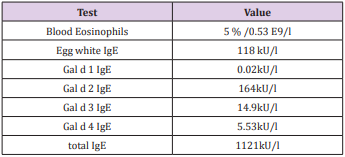A Case report: Importance of Molecular Allergy Diagnostics in Hen’s Egg Allergy
Clinical Report
Background
Hen’s egg allergy is one of the most common allergies in children with prevalence of max 2,5 % of children [1]. The prognosis of outgrowth is excellent [1] and many children with egg allergy can tolerate boiled egg [2]. Allergen specific IgE predicts the probability of developing a reaction and can help to decide whether an oral food challenge should be performed [3]. Many studies have been determined to make 95% predictive decision points that vary in different populations [3]. The allergen characterized in egg white include Gal d 1 (ovomucoid), Gal d 2(ovalbumin), Gal d 3 (conalbumin and Gal d 4 (lysozyme) [4]. Gal d 1 remains soluble after heating, as Gal d 2, 3 and 4 are unstable proteins and heating and enzymatic digestion reduces their allergenicity [4,5]. We describe a patient with very high level of egg white IgE, and ovalbumin IgE but negative ovomucoid IgE. The patient passed an oral food challenge with a cumulative dose of 875 mg of egg white protein.
Case Presentation
A 20-month-old child who was born full term by a cesarean section. The father of the child has atopic dermatitis and early childhood food allergies that outgrew with age. The mother had no history of atopy. The child developed severe atopic dermatitis beginning at the age of three months, which led to monitoring the child in the pediatric unit. The mother breastfed the child for 15 months and removed milk and eggs from her diet after which the condition of the skin seemed to improve. Finally, a calcineurin inhibitor treatment was started for atopic dermatitis after which the condition of the skin has remained good. At three months old, the laboratory findings were the following: egg white IgE was 51kU/l, milk IgE was 51kU/l, wheat IgE was 0.40kU/l. An accidental exposure to milk resulted in an urticarial reaction and vomiting. It was documented that the child didn’t receive any egg. In laboratory testing, that the child underwent at the age of 20 months, the findings were for milk and egg (Table 1). The total egg white antibodies were very high, but the Gal d 1-antibodies (ovomucoid) were negative. An open 4-step food oral challenge with boiled hen’s egg with a cumulative dose of 875 mg egg white protein was performed in the patient. The exposure did not cause any symptoms and the child was in good condition after monitoring at discharge. If egg white IgE results alone had been used, would the exposure most likely have been left undone. Ovomucoid IgE added significant value to the case.
Conclusion
Component-resolved diagnostics add value in relation to the total antibody level in the study of egg allergy. It is possible that the patient can tolerate boiled egg in spite of a very high antibody level. In the case in question, the probability of allergy was extremely high based on the egg white antibodies. However, ovomucoid IgE was low, which predicted tolerance to cooked egg. The patient was advised to avoid raw egg but introduce heated egg into the diet.
More BJSTR Articles : https://biomedres01.blogspot.com/


No comments:
Post a Comment
Note: Only a member of this blog may post a comment.